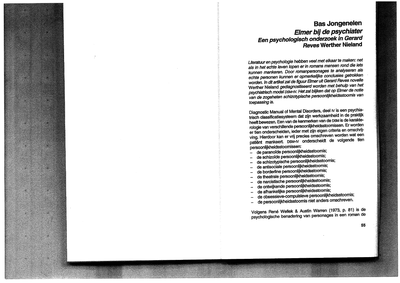Literatuur en psychologie hebben veel met elkaar te maken: net als in het echte leven lopen er in romans mensen rond die lets kunnen mankeren. Door romanpersonages te analyseren als echte personen kunnen er opmerkelijke conclusies getrokken worden. In dit artikel zal de figuur Elmer uit Gerard Reves novelle Werther Nieland gediagnostiseerd worden met behulp van het psychiatrisch model DSM-IV. Het zal blijken dat op Elmer de notie van de zogheten schizotypische persoonlijkheidsstoornis van toepassing is.
DOCUMENT

Purpose: Intellectual capital theory and practice predominantly focus on measuring and managing intangible assets. However, if we want to balance the intellectual capital books (Harvey and Lusch, 1999), we should recognize both intellectual assets and intellectual liabilities (Caddy, 2000). Therefore, the purpose of this article is to present a theoretical framework for measuring intellectual liabilities. Design: Identifying intangible liabilities is identifying the risk of decline and fall of organizations. One of the first extensive studies related to causes of decline and fall is Gibbon‟s Decline and Fall of the Roman Empire (Gibbon, 2003 [original publication 1776]). It seems as if the main lessons that were drawn from this study are also applicable to today‟s business environment. Therefore, the framework that is developed in this article is not only based on intellectual capital literature, but also on Gibbon‟s study into the causes of decline and fall of the Roman Empire. Findings: The findings are combined in a framework for measuring intellectual liabilities. The main distinction within the proposed framework is the distinction between internal and external liabilities. Internal liabilities refer to the causes of deterioration that arise from the sources of value creation within the organization. External liabilities refer to the causes of deterioration that come from outside and are beyond control of the organization. Originality: This article explores a relatively new topic (intellectual liabilities) from a perspective (historical sciences) that is hardly used in management science.
DOCUMENT

Stadsleven – The Happy City onderzoekt hoe een stad ontworpen kan worden om het geluk van haar bewoners te bevorderen. In deze gastcolumn verdedigt stadsgeograaf David ter Avest ons bijwijlen verlangen naar minder happy cities. Deze beleven we in romans, comics, films en games.
DOCUMENT
Met het Verdrag van Maastricht werd in 1992 de basis gelegd voor het streven naar een Europese dimensie in het onderwijs. Sindsdien hebben ontwikkelingen op het gebied van internationalisering en Europa op veel scholen een vlucht genomen, in de vorm van uitwisselingen, reisweken en andere internationale projecten. In het talenonderwijs biedt deze internationale blik niet alleen de gelegenheid om te werken aan taalvaardigheden: ook bij het onderdeel literatuur kan een dergelijk perspectief van meerwaarde zijn. In dit artikel bespreekt lerarenopleider en promovenda Anouk Zuurmond drie strategieën om een Europese dimensie te ontwikkelen in het literatuuronderwijs.
DOCUMENT

PCK is seen as the transformation of content knowledge and pedagogical knowledge into a different type of knowledge that is used to develop and carry out teaching strategies. To gain more insight into the extent to which PCK is content specific, the PCK about more topics or concepts should be compared. However, researchers have rarely compared teachers’ concrete PCK about more than one topic. To examine the content dependency of PCK, we captured the PCK of sixteen experienced Dutch history teachers about two historical contexts (i.e. topics) using interviews and Content Representation questionnaires. Analysis reveals that all history teachers’ PCK about the two contexts overlaps, although the degree of overlap differs. Teachers with relatively more overlap are driven by their overarching subject related goals and less by the historical context they teach. We discuss the significance of these outcomes for the role of teaching orientation as a part of PCK.
DOCUMENT

Dit boek vertelt het verhaal van boerendochters die niet op de boerderij zijn gebleven en een bestaan in de stad boven het leven op het platteland verkozen. Het is op een bijzondere manier tot stand gekomen: de vrouwen die worden geportretteerd hebben in een aantal bijeenkomsten hun levensverhalen met elkaar gereconstrueerd en er woorden aan gegeven. Dat reconstrueren en vertellen van de verhalen ging voor de vrouwen gepaard met de nodige emoties – daardoor getuigen de verhalen van passie, kracht en lef. De verhalen vertellen over het proces van weggaan en aankomen. De boerendochters verlieten hun geboortegrond en het erf en ontgroeiden het plattelandsmilieu. In het stedelijke milieu waar ze aankwamen, moesten ze wennen aan andere omgangsvormen en ongeschreven gedragsregels. Ze voelden zich lange tijd onzeker in dit nieuwe stadsmilieu. En sommigen vragen zich nog steeds af waar ze zich het meeste huis voelen: in de stad of op het platteland of in een zelfgecreëerde mengvorm van the best of both worlds. In de portretten van deze boerendochters die van het erf zijn afgegaan komt enerzijds naar voren wat er in het leven van deze vrouwen is veranderd en hoe hun kindertijd en jeugd op de boerderij hen in hun verdere leven heeft gevormd. Anderzijds blijkt eruit dat er ingrijpende veranderingen hebben plaatsgevonden op het platteland. Het platteland van hun jeugd bestaat veelal niet meer: veel boerenbedrijven zijn verdwenen, op boerenbedrijven die bleven vond mechanisatie en schaalvergroting plaats. En veel moderne boeren ontwikkelden nevenactiviteiten (en zo extra inkomsten) door een camping of zorgboerderij te beginnen. Daarnaast vestigden steeds meer stedelingen zich op het platteland. De zeer persoonlijke portretten in dit boek werpen een authentiek beeld op de veranderingen die zich hebben voltrokken zowel op het microniveau van de individuele levens van de boerendochters, als op het macroniveau van het platteland. Met bijdragen van: Gerda Aarnink (Twente); Hilde Bakker (Friesland); Aafke Boerhorst (Texel); Klasien van der Deen (Noordoostpolder); Sietske Dijkstra (Friesland); Nienke Dijkstra (Friesland); Lia van Doorn (Utrecht); Betty Mijlof (Drenthe); Trudi Miltenburg (Utrecht); Ineke van der Vlugt (Zuid-Holland).
LINK
There is a strong relation between food and identity. Especially when people move to another country, traditional food (or simply food from their country of origin), symbolizes a link with culture, communityand ethnic identity. As people move around the globe they introduce new foods in the places they land. Almere is becoming one of the largest majority minority cities of the Netherlands. Walking around thecity, the diversity of food ingredients and eating cultures as shown in shops and restaurants is immediately clear. The aim of this project was to get an insight into the diets of the residents of Almere so as to learn about eating patterns in a multicultural city and how multiculturality affects the diets of both newcomers and people who have been living here for generations.
DOCUMENT

geen samenvatting
DOCUMENT